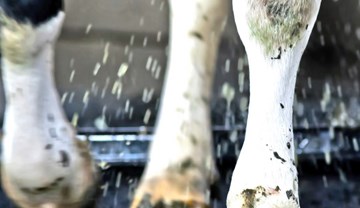- Home
- Nutrition and cow mobility
Nutrition and cow mobility
Nutritional factors have a significant impact upon foot health. This may be partly explained by the sole of the hoof having no direct blood supply and relies on nutrients being passed from the corium via diffusion, making these cells very susceptible to any disturbance in the blood circulation in the corium, and potentially causing softer, less-resilient feet that are more prone to disease and injury.
The balance between the concentrate and fibre constituents of the diet and how they influence the pH of the rumen are the most pressing nutritional issues with regard to mobility, as rumenacidosis has been linked to increased mobility problems in nutritional studies. Dietary protein levels and vitamin and minerals levels are also areas of concern.
Other essential aspects of effective nutrition include the importance of diet consistency and feeding times, regularly pushing-up feeds and providing adequate feed space and water trough space for herds, particularly those growing in size. Another important factor is being aware of heat stress affecting appetites in cattle housed during the summer months.
Acidosis caused by the feeding of high proportions of rapidly-fermentableconcentrates fed to dairy cows has been linked to mobility issues such as sole bruising and sole ulcers.
Sub-acute rumen acidosis (SARA) can occur when the rumen pH falls below 5.8, usually due to a rapid production and absorption of acids from the rumen when cattle consume too many concentrate feeds - particularly starch - in a short amount of time. The amount and types of grain included in a diet, how it was processed, and the forage type and quality strongly influence intake patterns, how energy is metabolised and the balance of the different acids produced as cows digest their food.
Where dietary rumen-fermentable concentrate levels are particularly high lactic acid accumulates and cannot be adequately processed by the cow. Lactic acid can disrupt the cow's metabolism and affect blood circulation. Increased rumen acidity causes some rumen microbes to die, and toxins are produced which releasehistaminein the bloodstream, which damages blood vessels, further affecting blood circulation and disrupting the delivery of important nutrients to the body, and particularly to the feet.
It is critical that a diet should contain ingredients with various levels of rumen carbohydrate availability in order to avoid acidosis; finely ground or highly processed cereals have the highest rates of ruminal starch digestion. In studies where a high fibre diet has been compared to a high concentrate diet with the same energy intake characteristics, cows fed the high fibre diet exhibited fewer mobility problems.
Fibre levels in dairy cow rations are of prime importance when producing a balanced, healthy diet that promotes good foot health. Levels of fibre in the diet, usually measured in terms of neutral detergent fibre (NDF) or acid detergent fibre (ADF) are crucial, particularly those provided by the forage part of the diet.
Total Mixed Rations (TMRs) must be properly mixed to reduce selective eating and sorting, and should contain a broad range of particle size. TMR particle size can be measured by The Penn State Particle Separator, which uses sieves of varying sizes to analyse ration particle size. A similar demonstration of the variety and proportion of particle size in a diet can be observed by putting a sample of the diet in a bucket of water and observing the effectiveness of a 'rumen mat' of fibrous material. Increased particle size increases cud chewing and saliva production, aiding more effective digestion of diet constituents.
Forage needs to be analysed in order to plan for well-complemented levels of concentrates to formulate a balanced diet, particularly when measuring the fibre levels in a ration. Low dry matter silage will restrict intake levels and can directly increase rumen acidity. Very high dry matter silage contains relatively lower levels of fibre. Longer forage chop lengths, while causing potential problems in clamp consolidation, stimulate better rumination and digestion and can help to maintain rumen pH. Some farms may include hay, straw and baled silage in dairy cow TMRs in order to help prevent SARA.
Excess dietary crude protein levels, combined with a low fibre intake, are also suspected to cause mobility problems.Studies examining the association between the quality and quantity of dietary protein on claw health have suggested that cows fed higher levels of crude protein have increased incidence and duration of lameness. It is believed that the products of protein degradation, particularly ammonia, in the rumen may be influential in the increased mobility problems.
The digital cushioning provided by the tissues in the bottom of each foot is essential in aiding blood circulation, playing a vital role in the formation of new horn and help to reduce the negative effects of pressure applied to the hoof from ordinary activity such as walking on hard surfaces. This cushion consists of saturated fat in heifers and unsaturated fat in cows. The size of the cushion and the fat composition is linked to Body Condition Score (BCS); as BCS declines, so does the size and type of fat in the cushion due to body fat mobilisation, thus managing BCS is particularly pertinent to maintaining good foot health.
Related links & publications

Lameness
Our tools and resources to help you manage lameness on your farm

